Drivers of Structural and Functional Resilience Following Extreme Fires in Boreal Forests of Northeast China
Abstract
:1. Introduction
2. Materials and Methods
2.1. Study Area
2.2. Ecosystem Resilience Evaluation Using MODIS Products
2.2.1. MODIS Products and Processing
2.2.2. Ecosystem Resilience Evaluation Model
2.3. Explanatory Variables to Model Forest Resilience
2.3.1. Prefire Vegetation Composition
2.3.2. Topography
2.3.3. Burn Severity
2.3.4. Climatic Factors
2.3.5. Explanatory Variables
2.4. Statistical Analysis
2.4.1. Gradient Boosting Machine Modeling
2.4.2. Shapley Additive Explanation
3. Results
3.1. Postfire Recovery of Structural and Functional Parameters
3.2. Spatial Pattern of Ecosystem Resilience
3.3. GBM-SHAP Modeling for Ecosystem Resilience
3.3.1. Model Validation and Variable Importance
3.3.2. Explanation of Drivers Regulating Ecosystem Resilience
4. Discussion
5. Conclusions
Author Contributions
Funding
Institutional Review Board Statement
Informed Consent Statement
Data Availability Statement
Acknowledgments
Conflicts of Interest
Abbreviations
| NPP | Net primary productivity |
| ET | Evapotranspiration |
| LAI | Leaf area index |
| SHAP | Shapley Additive Explanation s |
References
- Mann, C.; Hernández-Morcillo, M.; Ikei, H.; Miyazaki, Y. The socioeconomic dimension of forest therapy: A contribution to human well-being and sustainable forest management. Trees For. People 2024, 18, 100731. [Google Scholar] [CrossRef]
- Jones, M.W.; Abatzoglou, J.T.; Veraverbeke, S.; Andela, N.; Lasslop, G.; Forkel, M.; Smith, A.J.P.; Burton, C.; Betts, R.A.; van der Werf, G.R.; et al. Global and Regional Trends and Drivers of Fire Under Climate Change. Rev. Geophys. 2022, 60, e2020RG000726. [Google Scholar] [CrossRef]
- Johnstone, J.F.; Celis, G.; Chapin III, F.S.; Hollingsworth, T.N.; Jean, M.; Mack, M.C. Factors shaping alternate successional trajectories in burned black spruce forests of Alaska. Ecosphere 2020, 11, e03129. [Google Scholar] [CrossRef]
- Scheffer, M.; Hirota, M.; Holmgren, M.; Van Nes, E.H.; Chapin III, F.S. Thresholds for boreal biome transitions. Proc. Natl. Acad. Sci. USA 2012, 109, 21384–21389. [Google Scholar] [CrossRef] [PubMed]
- Stevens-Rumann, C.; Morgan, P. Repeated wildfires alter forest recovery of mixed-conifer ecosystems. Ecol. Appl. Publ. Ecol. Soc. Am. 2016, 26, 1842–1853. [Google Scholar] [CrossRef]
- Whitman, E.; Parisien, M.-A.; Thompson, D.K.; Flannigan, M.D. Topoedaphic and Forest Controls on Postfire Vegetation Assemblies Are Modified by Fire History and Burn Severity in the Northwestern Canadian Boreal Forest. Forests 2018, 9, 151. [Google Scholar] [CrossRef]
- Baho, D.L.; Allen, C.R.; Garmestani, A.S.; Fried-Petersen, H.B.; Renes, S.E.; Gunderson, L.H.; Angeler, D.G. A quantitative framework for assessing ecological resilience. Ecol. Soc. J. Integr. Sci. Resil. Sustain. 2017, 22, 1–17. [Google Scholar] [CrossRef]
- Sasaki, T.; Furukawa, T.; Iwasaki, Y.; Seto, M.; Mori, A.S. Perspectives for ecosystem management based on ecosystem resilience and ecological thresholds against multiple and stochastic disturbances. Ecol. Indic. 2015, 57, 395–408. [Google Scholar] [CrossRef]
- Holling, C.S. Resilience and Stability of Ecological Systems. Annu. Rev. Ecol. Syst. 1973, 4, 1–23. [Google Scholar] [CrossRef]
- Higuera, P.E.; Metcalf, A.L.; Miller, C.; Buma, B.; McWethy, D.B.; Metcalf, E.C.; Ratajczak, Z.; Nelson, C.R.; Chaffin, B.C.; Stedman, R.C.; et al. Integrating Subjective and Objective Dimensions of Resilience in Fire-Prone Landscapes. Bioscience 2019, 69, 379–388. [Google Scholar] [CrossRef]
- Seidl, R.; Fernandes, P.M.; Fonseca, T.F.; Gillet, F.; Jönsson, A.M.; Merganičová, K.; Netherer, S.; Arpaci, A.; Bontemps, J.-D.; Bugmann, H.; et al. Modelling natural disturbances in forest ecosystems: A review. Ecol. Model. 2011, 222, 903–924. [Google Scholar] [CrossRef]
- Seidl, R.; Thom, D.; Kautz, M.; Martin-Benito, D.; Peltoniemi, M.; Vacchiano, G.; Wild, J.; Ascoli, D.; Petr, M.; Honkaniemi, J.; et al. Forest disturbances under climate change. Nat. Clim. Chang. 2017, 7, 395–402. [Google Scholar] [CrossRef]
- Turner, M.G. Disturbance and landscape dynamics in a changing world. Ecology 2010, 91, 2833–2849. [Google Scholar] [CrossRef] [PubMed]
- Folke, C.; Carpenter, S.R.; Walker, B.; Scheffer, M.; Chapin, T.; Rockström, J. Resilience Thinking: Integrating Resilience, Adaptability and Transformability. Ecol. Soc. 2010, 15, 20. [Google Scholar] [CrossRef]
- Cumming, G.S.; Barnes, G.; Perz, S.; Schmink, M.; Sieving, K.E.; Southworth, J.; Binford, M.; Holt, R.D.; Stickler, C.; Van Holt, T. An Exploratory Framework for the Empirical Measurement of Resilience. Ecosystems 2005, 8, 975–987. [Google Scholar] [CrossRef]
- Yi, C.; Jackson, N. A review of measuring ecosystem resilience to disturbance. Environ. Res. Lett. 2021, 16, 053008. [Google Scholar] [CrossRef]
- Stephens, S.L.; Collins, B.M.; Fettig, C.J.; Finney, M.A.; Hoffman, C.M.; Knapp, E.E.; North, M.P.; Safford, H.; Wayman, R.B. Drought, Tree Mortality, and Wildfire in Forests Adapted to Frequent Fire. BioScience 2018, 68, 77–88. [Google Scholar] [CrossRef]
- Stevens-Rumann, C.S.; Kemp, K.B.; Higuera, P.E.; Harvey, B.J.; Rother, M.T.; Donato, D.C.; Morgan, P.; Veblen, T.T. Evidence for declining forest resilience to wildfires under climate change. Ecol. Lett. 2018, 21, 243–252. [Google Scholar] [CrossRef]
- North, M.P.; Tompkins, R.E.; Bernal, A.A.; Collins, B.M.; Stephens, S.L.; York, R.A. Operational resilience in western US frequent-fire forests. For. Ecol. Manag. 2022, 507, 120004. [Google Scholar] [CrossRef]
- Fernandez-Manso, A.; Quintano, C.; Roberts, D.A. Burn severity influence on postfire vegetation cover resilience from Landsat MESMA fraction images time series in Mediterranean forest ecosystems. Remote Sens. Environ. 2016, 184, 112–123. [Google Scholar] [CrossRef]
- João, T.; João, G.; Bruno, M.; João, H. Indicator-based assessment of postfire recovery dynamics using satellite NDVI time-series. Ecol. Indic. 2018, 89, 199–212. [Google Scholar] [CrossRef]
- Parks, S.A.; Holsinger, L.M.; Panunto, M.H.; Jolly, W.M.; Dobrowski, S.Z.; Dillon, G.K. High-severity fire: Evaluating its key drivers and mapping its probability across western US forests. Environ. Res. Lett. 2018, 13, 044037. [Google Scholar] [CrossRef]
- Spasojevic, M.J.; Bahlai, C.A.; Bradley, B.A.; Butterfield, B.J.; Tuanmu, M.-N.; Sistla, S.; Wiederholt, R.; Suding, K.N. Scaling up the diversity–resilience relationship with trait databases and remote sensing data: The recovery of productivity after wildfire. Glob. Chang. Biol. 2016, 22, 1421–1432. [Google Scholar] [CrossRef] [PubMed]
- Löf, M.; Madsen, P.; Metslaid, M.; Witzell, J.; Jacobs, D.F. Restoring forests: Regeneration and ecosystem function for the future. New For. 2019, 50, 139–151. [Google Scholar] [CrossRef]
- Seidl, R.; Turner, M.G. Post-disturbance reorganization of forest ecosystems in a changing world. Proc. Natl. Acad. Sci. USA 2022, 119, e2202190119. [Google Scholar] [CrossRef]
- Harvey, B.J.; Donato, D.C.; Turner, M.G. High and dry: Postfire tree seedling establishment in subalpine forests decreases with postfire drought and large stand-replacing burn patches. Glob. Ecol. Biogeogr. 2016, 25, 655–669. [Google Scholar] [CrossRef]
- Lipoma, L.; Kambach, S.; Díaz, S.; Sabatini, F.M.; Damasceno, G.; Kattge, J.; Wirth, C.; Abella, S.R.; Beierkuhnlein, C.; Belote, T.R.; et al. No general support for functional diversity enhancing resilience across terrestrial plant communities. Glob. Ecol. Biogeogr. 2024, 33, e13895. [Google Scholar] [CrossRef]
- Lausch, A.; Erasmi, S.; King, D.J.; Magdon, P.; Heurich, M. Understanding Forest Health with Remote Sensing-Part II—A Review of Approaches and Data Models. Remote Sens. 2017, 9, 129. [Google Scholar] [CrossRef]
- Pretzsch, H.; del Río, M.; Biber, P.; Arcangeli, C.; Bielak, K.; Brang, P.; Dudzinska, M.; Forrester, D.I.; Klädtke, J.; Kohnle, U.; et al. Maintenance of long-term experiments for unique insights into forest growth dynamics and trends: Review and perspectives. Eur. J. For. Res. 2019, 138, 165–185. [Google Scholar] [CrossRef]
- Mandl, L.; Viana-Soto, A.; Seidl, R.; Stritih, A.; Senf, C. Unmixing-based forest recovery indicators for predicting long-term recovery success. Remote Sens. Environ. 2024, 308, 114194. [Google Scholar] [CrossRef]
- Zhu, Z.; Zhang, J.; Yang, Z.; Aljaddani, A.H.; Cohen, W.B.; Qiu, S.; Zhou, C. Continuous monitoring of land disturbance based on Landsat time series. Remote Sens. Environ. 2020, 238, 111116. [Google Scholar] [CrossRef]
- Fang, L.; Yang, J.; Zu, J.; Li, G.; Zhang, J. Quantifying influences and relative importance of fire weather, topography, and vegetation on fire size and fire severity in a Chinese boreal forest landscape. For. Ecol. Manag. 2015, 356, 2–12. [Google Scholar] [CrossRef]
- Qi, Y.; Li, F. Remote Sensing Estimation of Aboveground Forest Carbon Storage in Daxing’an Mountains Based on KNN Method. Sci. Silvae Sin. 2015, 51, 46–55. [Google Scholar]
- Wang, C.; Gower, S.T.; Wang, Y.; Zhao, H.; Yan, P.; Lamberty, B.P. The influence of fire on carbon distribution and net primary production of boreal larix gmelinii forests in north-eastern China. Glob. Chang. Biol. 2001, 7, 719–730. [Google Scholar] [CrossRef]
- Cai, W.; Yang, J. High-severity fire reduces early successional boreal larch forest aboveground productivity by shifting stand density in north-eastern China. Int. J. Wildland Fire 2016, 25, 861–875. [Google Scholar] [CrossRef]
- Fang, L.; Yang, J. Atmospheric effects on the performance and threshold extrapolation of multi-temporal Landsat derived dNBR for burn severity assessment. Int. J. Appl. Earth Obs. Geoinf. 2014, 33, 10–20. [Google Scholar] [CrossRef]
- Fang, L.; Yang, J.; Zhang, W.; Zhang, W.; Yan, Q. Combining allometry and landsat-derived disturbance history to estimate tree biomass in subtropical planted forests. Remote Sens. Environ. 2019, 235, 111423. [Google Scholar] [CrossRef]
- Stukel, M.R.; Décima, M.; Kelly, T.B.; Landry, M.R.; Nodder, S.D.; Ohman, M.D.; Selph, K.E.; Yingling, N. Relationships Between Plankton Size Spectra, Net Primary Production, and the Biological Carbon Pump. Glob. Biogeochem. Cycles 2024, 38, e2023GB007994. [Google Scholar] [CrossRef]
- Kool, D.; Agam, N.; Lazarovitch, N.; Heitman, J.L.; Sauer, T.J.; Ben-Gal, A. A review of approaches for evapotranspiration partitioning. Agric. For. Meteorol. 2014, 184, 56–70. [Google Scholar] [CrossRef]
- Zhang, X.; Liu, L.; Chen, X.; Gao, Y.; Xie, S.; Mi, J. GLC_FCS30: Global land-cover product with fine classification system at 30 m using time-series Landsat imagery. Earth Syst. Sci. Data 2021, 13, 2753–2776. [Google Scholar] [CrossRef]
- Fang, L.; Crocker, E.V.; Yang, J.; Yan, Y.; Yang, Y.; Liu, Z. Competition and Burn Severity Determine Postfire Sapling Recovery in a Nationally Protected Boreal Forest of China: An Analysis from Very High-Resolution Satellite Imagery. Remote Sens. 2019, 11, 603. [Google Scholar] [CrossRef]
- van Wagtendonk, J.W.; Root, R.R.; Key, C.H. Comparison of AVIRIS and Landsat ETM+ detection capabilities for burn severity. Remote Sens. Environ. 2004, 92, 397–408. [Google Scholar] [CrossRef]
- Miller, J.D.; Knapp, E.E.; Key, C.H.; Skinner, C.N.; Isbell, C.J.; Creasy, R.M.; Sherlock, J.W. Calibration and validation of the relative differenced Normalized Burn Ratio (RdNBR) to three measures of fire severity in the Sierra Nevada and Klamath Mountains, California, USA. Remote Sens. Environ. 2009, 113, 645–656. [Google Scholar] [CrossRef]
- Soverel, N.O.; Perrakis, D.D.B.; Coops, N.C. Estimating burn severity from Landsat dNBR and RdNBR indices across western Canada. Remote Sens. Environ. 2010, 114, 1896–1909. [Google Scholar] [CrossRef]
- Elith, J.; Leathwick, J.R.; Hastie, T. A working guide to boosted regression trees. J. Anim. Ecol. 2008, 77, 802–813. [Google Scholar] [CrossRef]
- Friedman, J.H. Greedy function approximation: A gradient boosting machine. Ann. Stat. 2001, 29, 1189–1232. [Google Scholar] [CrossRef]
- Lundberg, S.M.; Lee, S.I. A unified approach to interpreting model predictions. Adv. Neural Inf. Process. Syst. 2017, 30, 4768–4777. [Google Scholar]
- Mndela, M.; Tjelele, J.T.; Madakadze, I.C.; Mangwane, M.; Samuels, I.M.; Muller, F.; Pule, H.T. A global meta-analysis of woody plant responses to elevated CO2: Implications on biomass, growth, leaf N content, photosynthesis and water relations. Ecol. Process. 2022, 11, 52. [Google Scholar] [CrossRef]
- Li, X.; Gentine, P.; Lin, C.; Zhou, S.; Sun, Z.; Zheng, Y.; Liu, J.; Zheng, C. A simple and objective method to partition evapotranspiration into transpiration and evaporation at eddy-covariance sites. Agric. For. Meteorol. 2019, 265, 171–182. [Google Scholar] [CrossRef]
- Turner, M.G.; Chapin, F.S. Causes and Consequences of Spatial Heterogeneity in Ecosystem Function. In Ecosystem Function in Heterogeneous Landscapes; Springer: Berlin/Heidelberg, Germany, 2005; pp. 9–30. [Google Scholar]
- Han, D.; Wang, G.; Liu, T.; Xue, B.-L.; Kuczera, G.; Xu, X. Hydroclimatic response of evapotranspiration partitioning to prolonged droughts in semiarid grassland. J. Hydrol. 2018, 563, 766–777. [Google Scholar] [CrossRef]
- Lin, H.; Chen, Y.; Zhang, H.; Fu, P.; Fan, Z. Stronger cooling effects of transpiration and leaf physical traits of plants from a hot dry habitat than from a hot wet habitat. Funct. Ecol. 2017, 31, 2202–2211. [Google Scholar] [CrossRef]
- Carrà, B.G.; Bombino, G.; Denisi, P.; Plaza-Àlvarez, P.A.; Lucas-Borja, M.E.; Zema, D.A. Water Infiltration after Prescribed Fire and Soil Mulching with Fern in Mediterranean Forests. Hydrology 2021, 8, 95. [Google Scholar] [CrossRef]
- Littell, J.S.; Peterson, D.L.; Riley, K.L.; Liu, Y.; Luce, C.H. A review of the relationships between drought and forest fire in the United States. Glob. Chang. Biol. 2016, 22, 2353–2369. [Google Scholar] [CrossRef] [PubMed]
- Balch, J.K.; Iglesias, V.; Mahood, A.L.; Cook, M.C.; Amaral, C.; DeCastro, A.; Leyk, S.; McIntosh, T.L.; Nagy, R.C.; St Denis, L.; et al. The fastest-growing and most destructive fires in the US (2001 to 2020). Science 2024, 386, 425–431. [Google Scholar] [CrossRef] [PubMed]
- Kharuk, V.I.; Ponomarev, E.I.; Ivanova, G.A.; Dvinskaya, M.L.; Coogan, S.C.P.; Flannigan, M.D. Wildfires in the Siberian taiga. Ambio 2021, 50, 1953–1974. [Google Scholar] [CrossRef]
- Harvey, B.J.; Donato, D.C.; Turner, M.G. Burn me twice, shame on who? Interactions between successive forest fires across a temperate mountain region. Ecology 2016, 97, 2272–2282. [Google Scholar] [CrossRef]
- Chen, J.; McGuire, K.J.; Stewart, R.D. Effect of soil water-repellent layer depth on post-wildfire hydrological processes. Hydrol. Process. 2020, 34, 270–283. [Google Scholar] [CrossRef]
- Vieira, D.C.S.; Malvar, M.C.; Martins, M.A.S.; Serpa, D.; Keizer, J.J. Key factors controlling the postfire hydrological and erosive response at micro-plot scale in a recently burned Mediterranean forest. Geomorphology 2018, 319, 161–173. [Google Scholar] [CrossRef]
- Weatherholt, J.A.; Johnson, B.G. Evaluating the occurrence and spatial patterns of soil water repellency in the Deschutes National Forest, Oregon. Soil Sci. Soc. Am. J. 2024, 88, 1014–1026. [Google Scholar] [CrossRef]
- Gustine, R.N.; Hanan, E.J.; Robichaud, P.R.; Elliot, W.J. From burned slopes to streams: How wildfire affects nitrogen cycling and retention in forests and fire-prone watersheds. Biogeochemistry 2022, 157, 51–68. [Google Scholar] [CrossRef]
- Smith, H.G.; Sheridan, G.J.; Lane, P.N.J.; Nyman, P.; Haydon, S. Wildfire effects on water quality in forest catchments: A review with implications for water supply. J. Hydrol. 2011, 396, 170–192. [Google Scholar] [CrossRef]
- Liu, X.; Jiao, L.; Cheng, D.; Liu, J.; Li, Z.; Li, Z.; Wang, C.; He, X.; Cao, Y.; Gao, G. Light thinning effectively improves forest soil water replenishment in water-limited areas: Observational evidence from Robinia pseudoacacia plantations on the Loess Plateau, China. J. Hydrol. 2024, 637, 131408. [Google Scholar] [CrossRef]
- Sun, S.-S.; Liu, X.-P.; Zhao, X.-Y.; Medina-Roldánd, E.; He, Y.-H.; Lv, P.; Hu, H.-J. Annual Herbaceous Plants Exhibit Altered Morphological Traits in Response to Altered Precipitation and Drought Patterns in Semiarid Sandy Grassland, Northern China. Front. Plant Sci. 2022, 13, 756950. [Google Scholar] [CrossRef]
- Lawson, T.; Vialet-Chabrand, S. Speedy stomata, photosynthesis and plant water use efficiency. New Phytol. 2019, 221, 93–98. [Google Scholar] [CrossRef] [PubMed]
- Carminati, A.; Javaux, M. Soil Rather Than Xylem Vulnerability Controls Stomatal Response to Drought. Trends Plant Sci. 2020, 25, 868–880. [Google Scholar] [CrossRef]
- Smith, D.M.; Inman-Bamber, N.G.; Thorburn, P.J. Growth and function of the sugarcane root system. Field Crops Res. 2005, 92, 169–183. [Google Scholar] [CrossRef]
- Béland, M.; Baldocchi, D.D. Vertical structure heterogeneity in broadleaf forests: Effects on light interception and canopy photosynthesis. Agric. For. Meteorol. 2021, 307, 108525. [Google Scholar] [CrossRef]
- Sercu, B.K.; Baeten, L.; van Coillie, F.; Martel, A.; Lens, L.; Verheyen, K.; Bonte, D. How tree species identity and diversity affect light transmittance to the understory in mature temperate forests. Ecol. Evol 2017, 7, 10861–10870. [Google Scholar] [CrossRef]
- Tanioka, Y.; Ida, H.; Hirota, M. Relationship between Canopy Structure and Community Structure of the Understory Trees in a Beech Forest in Japan. Forests 2022, 13, 494. [Google Scholar] [CrossRef]
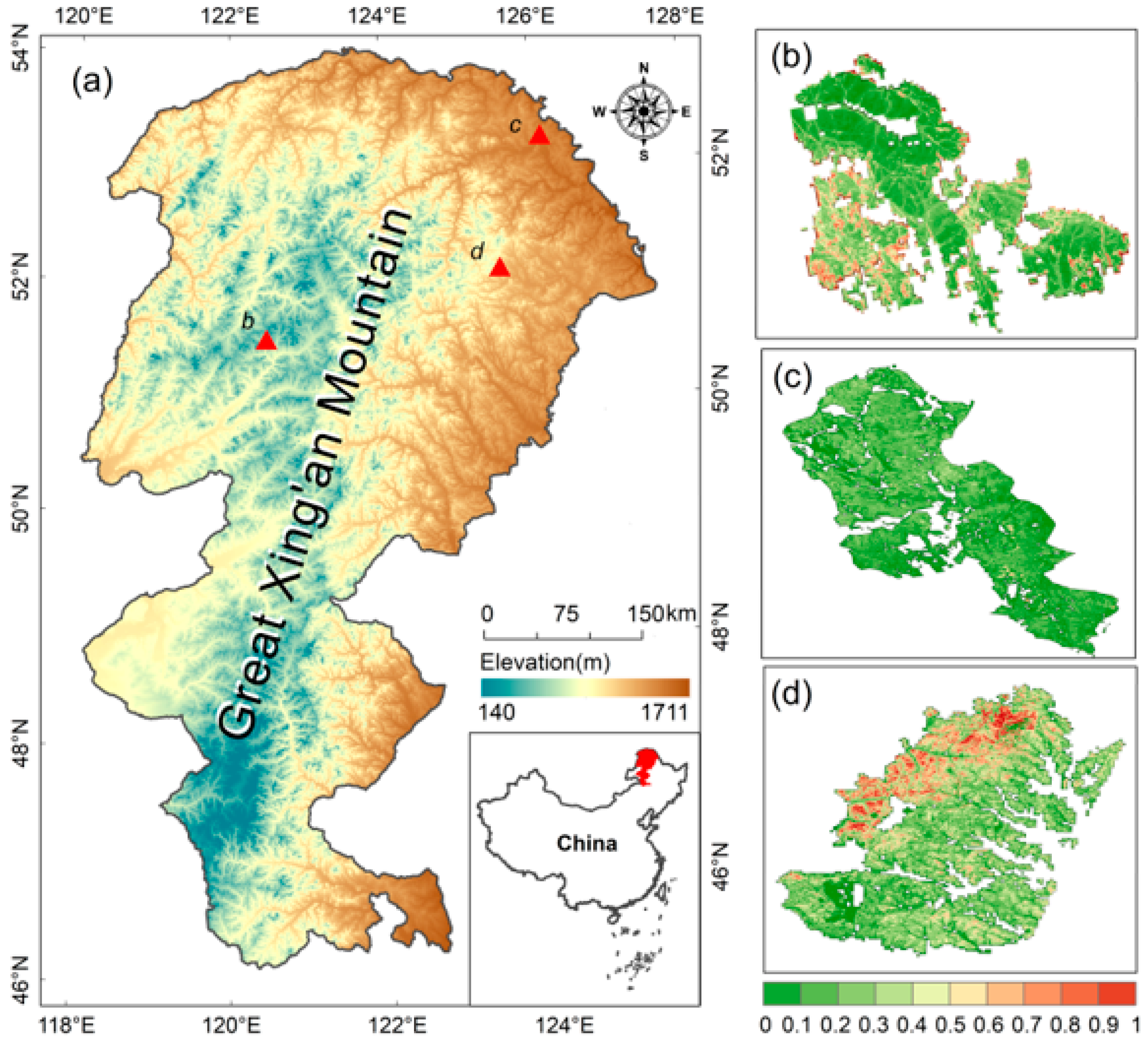
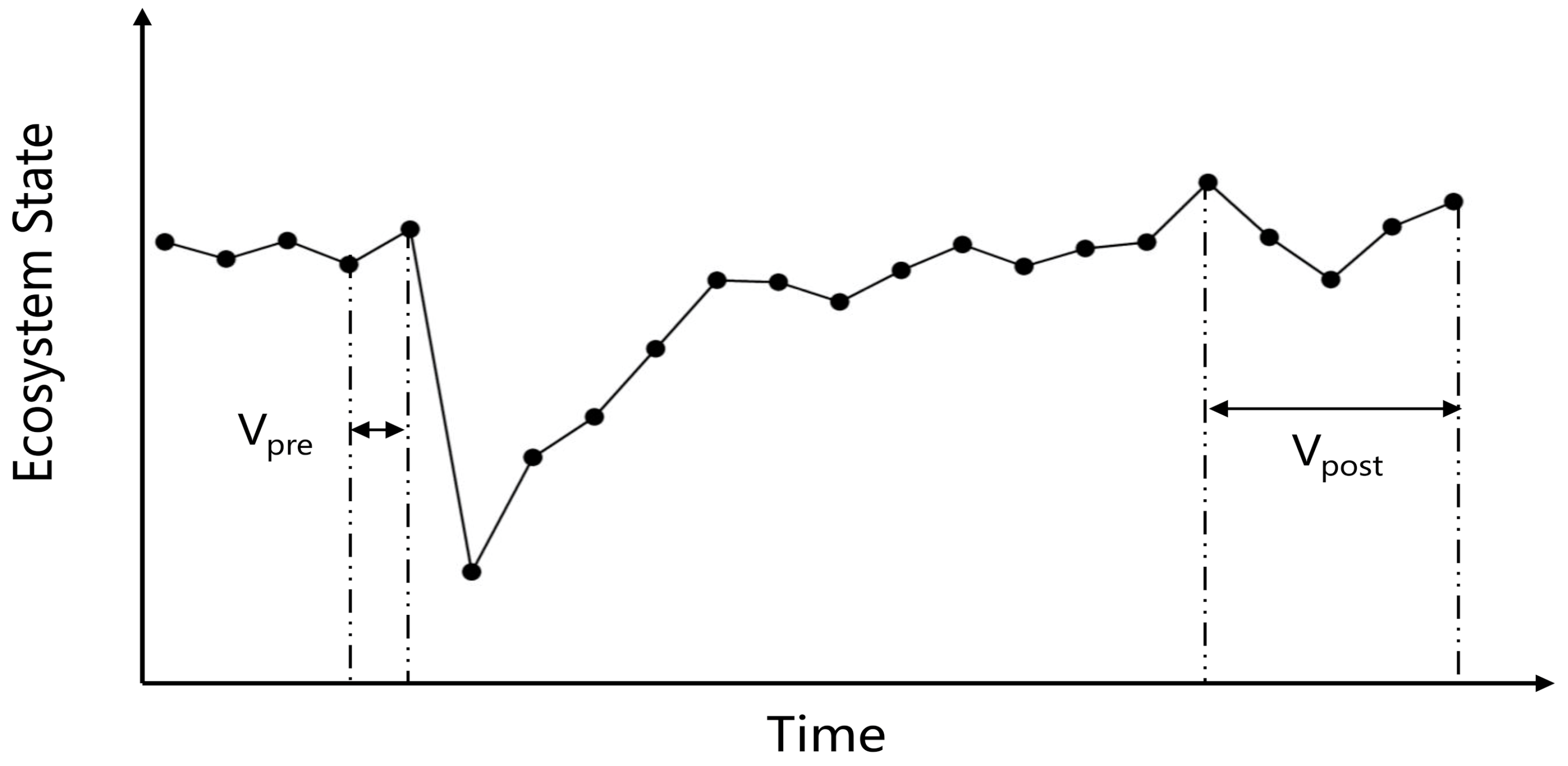
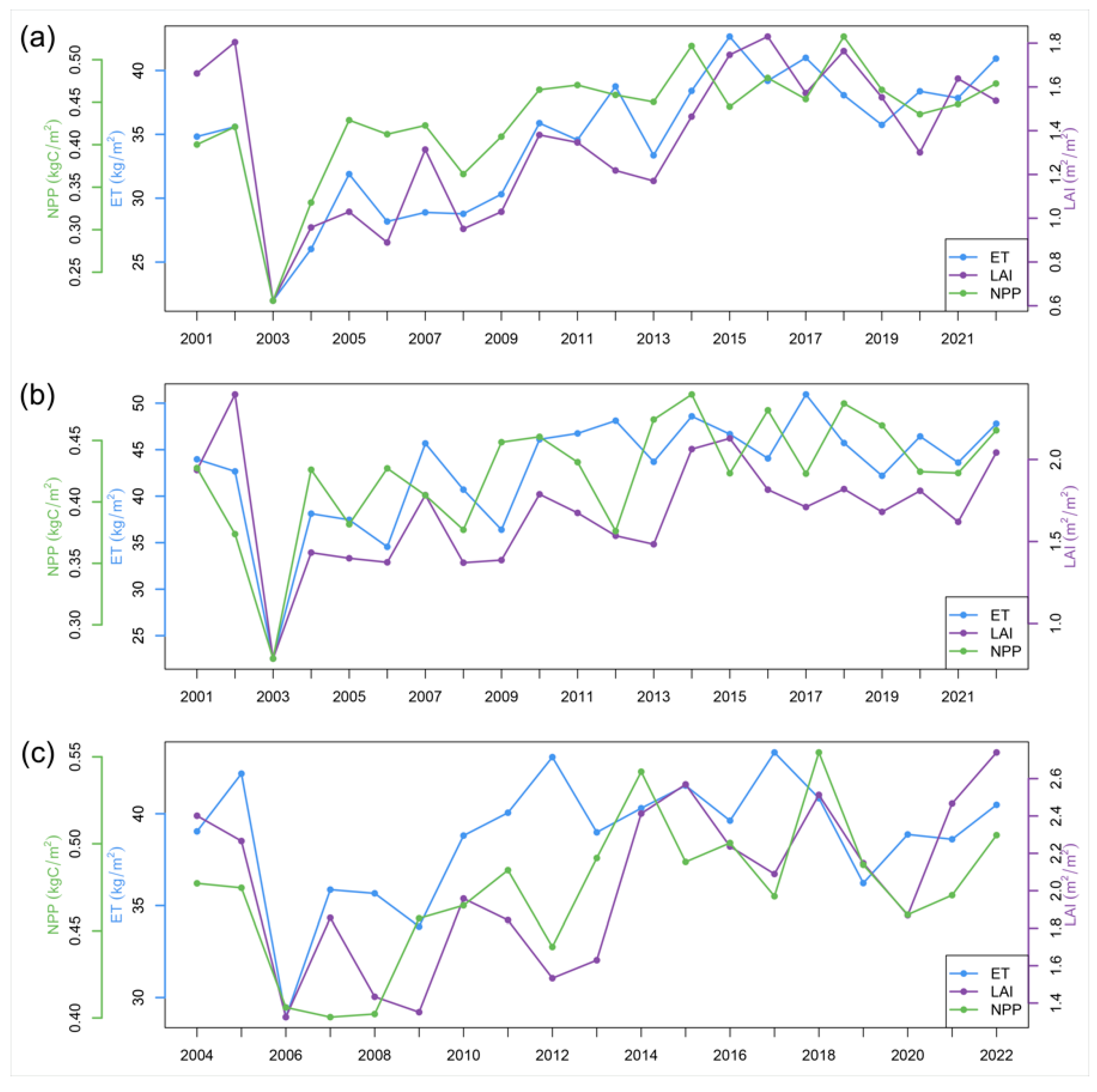
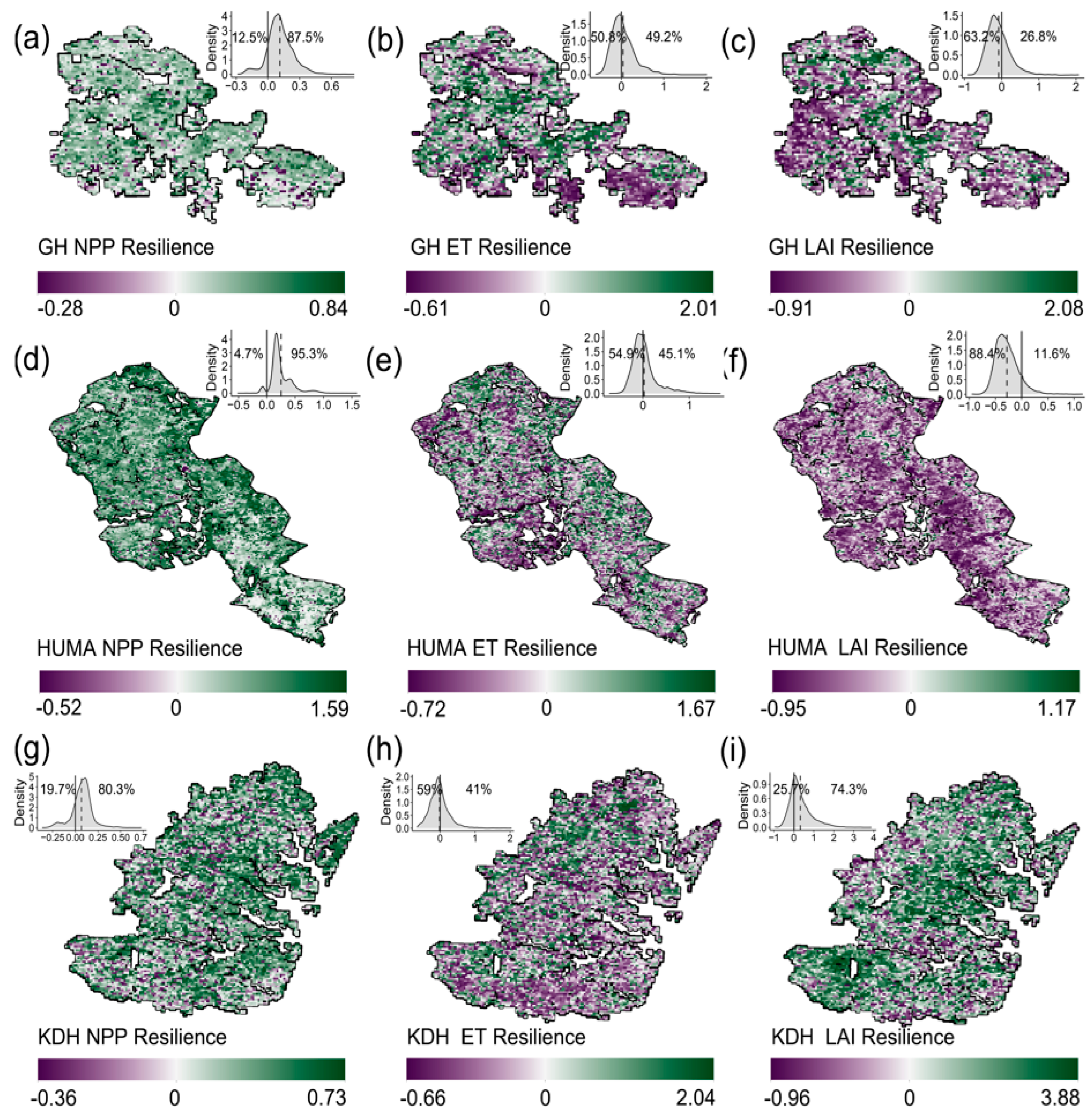
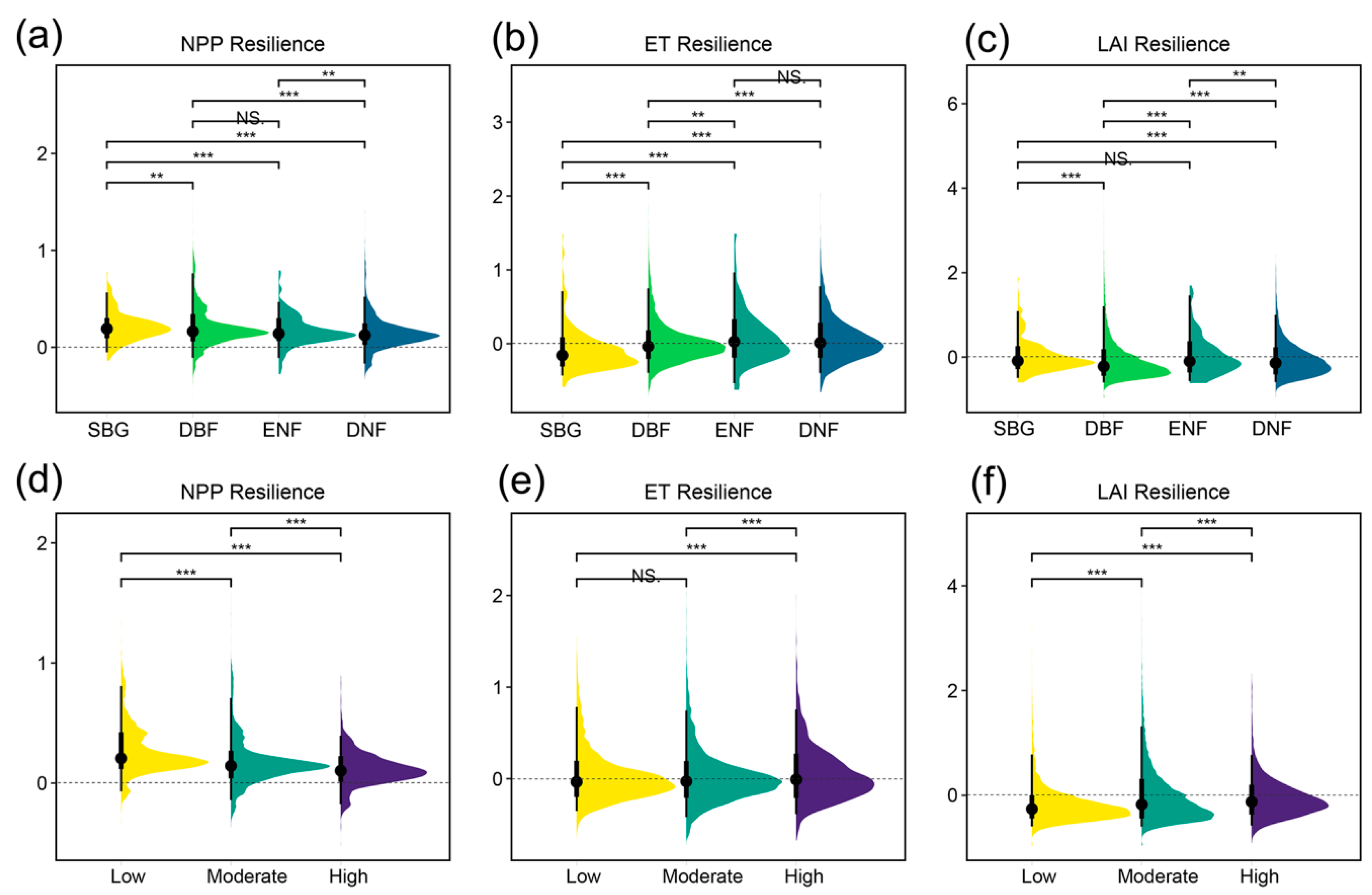
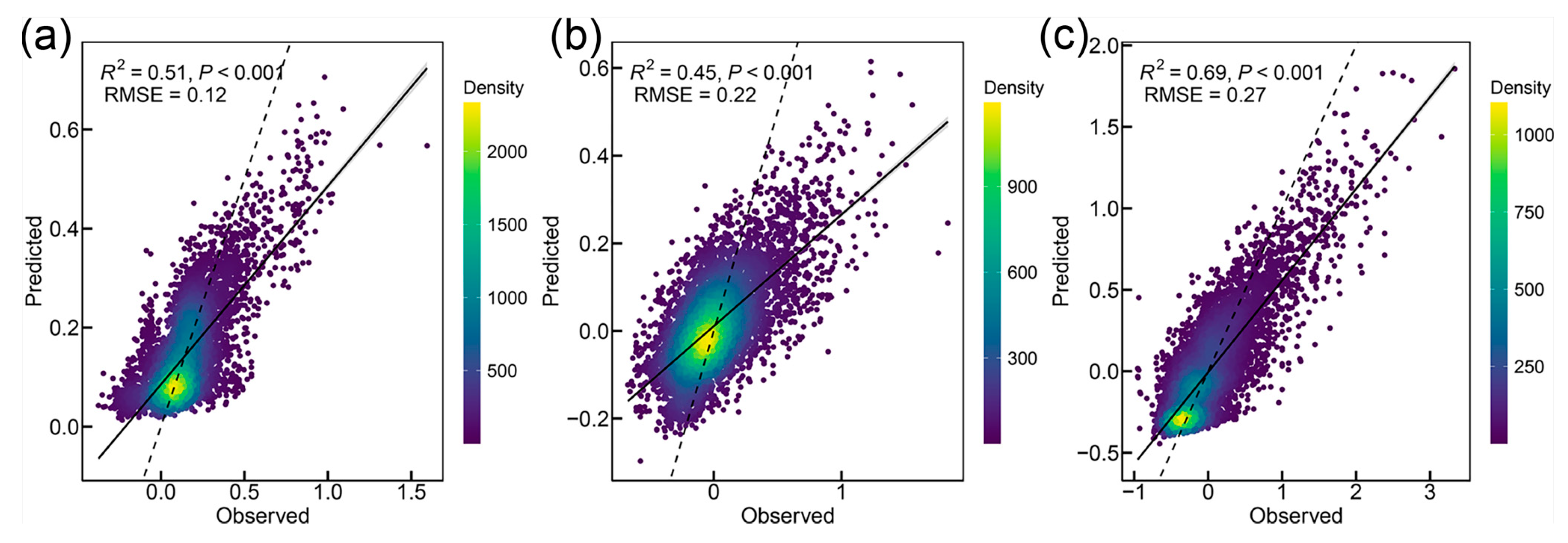



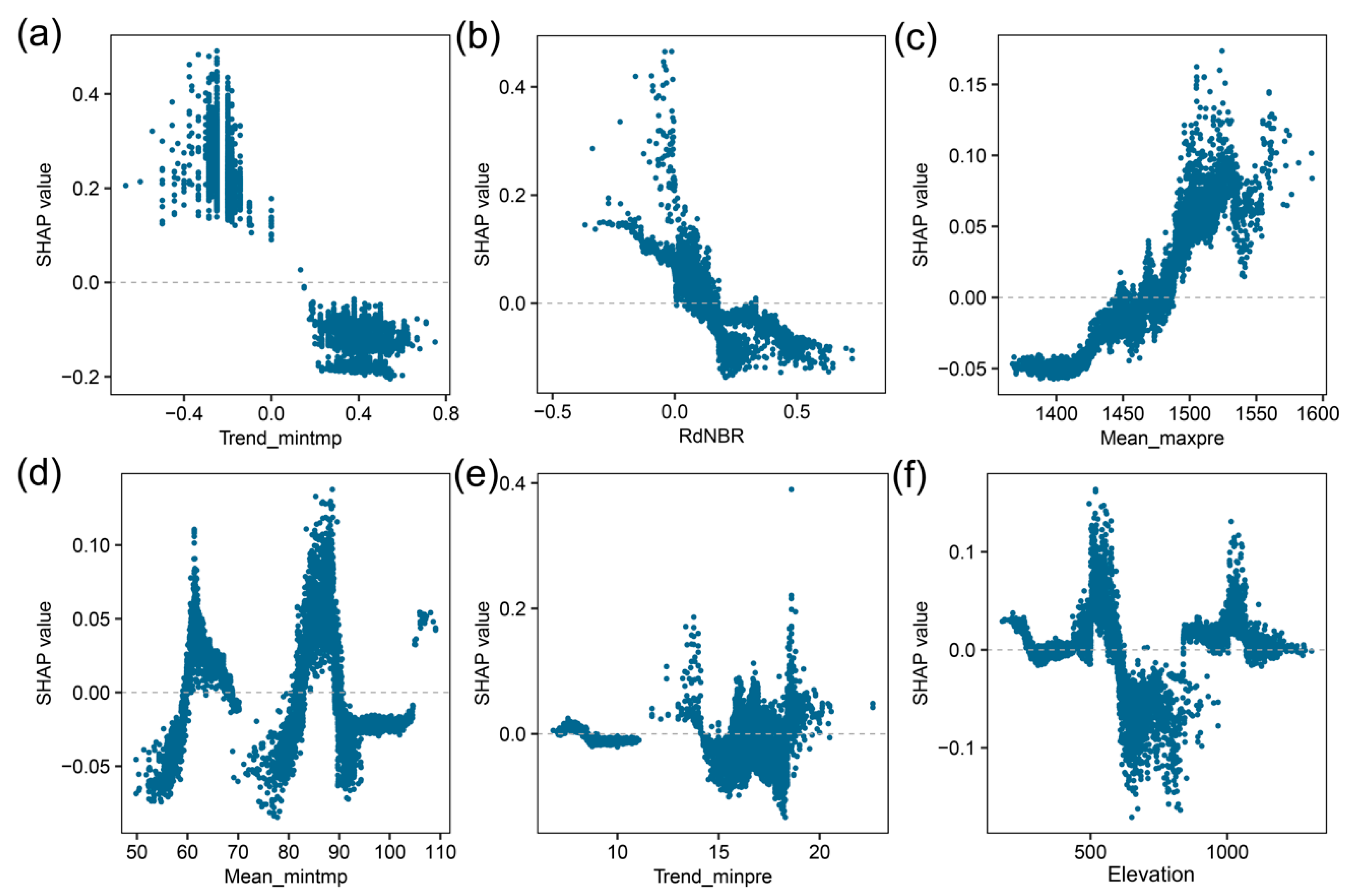
| Fire Name | Ignition Source | Occurrence Date | End Date | Burned Area (km2) |
|---|---|---|---|---|
| GH | Human-caused | 05/05/2023 | 11/05/2003 | 776.55 |
| Huma | Human-caused | 22/03/2003 | 04/04/2003 | 2729.84 |
| KDH | Lightning-ignited | 22/05/2006 | 03/06/2006 | 1723.25 |
| Fire Name | Path/Row | Prefire Image Date | Postfire Image Date |
|---|---|---|---|
| GH | 122/24 | 26/07/2002 | 11/06/2003, |
| Huma | 120/23 | 26/06/2002 | 02/08/2004 |
| KDH | 120/24 | 02/06/2005 | 08/08/2006 |
| Types | Variable Name | Description and Processing |
|---|---|---|
| Topography | ||
| Elevation | Altitude of given pixel above sea level derived from SRTM | |
| Slope | Steepness or incline of the terrain in degrees | |
| PSR | Amount of solar energy that could be received by a surface; the southwest-facing slopes receive more solar radiation | |
| Burn Severity | ||
| RdNBR | Median value of RdNBR represents fire-caused ecosystem changes | |
| Prefire Vegetation Composition | ||
| DBF | Proportion of deciduous broadleaved forest before fire | |
| ENF | Proportion of evergreen needle-leaved forest before fire | |
| DNF | Proportion of deciduous needle-leaved forest before fire | |
| SBG | Proportion of shrub- and grassland before fire | |
| Climatic Factors | ||
| PRE_SMK_SLOPE 1 | Rate of change in monthly precipitation within 16 years postfire | |
| TMP_SMK_SLOPE 1 | Rate of change in monthly mean temperature within 16 years postfire | |
| Mean_AI | Mean aridity index within 16 years postfire to indicate the average status of dryness | |
| Max_AI | Maximum aridity index within 16 years postfire to indicate the most extreme dryness condition | |
| Trend_AI 2 | Rate of change in annual aridity index within 16 years postfire | |
| Mean_maxpre | Mean status of maximum precipitation in growing season derived from the annual maximum precipitation within 16 years postfire to indicate extreme moist condition | |
| Trend_maxpre 2 | Rate of change in annual maximum precipitation during growing season within 16 years postfire | |
| Mean_minpre | Mean status of minimum precipitation in growing season derived from the annual minimum precipitation within 16 years postfire to indicate extreme dryness condition | |
| Trend_minpre 2 | Rate of change in annual minimum precipitation during growing season within 16 years postfire | |
| Mean_maxtmp | Mean status of the highest air temperature in growing season derived from the annual maximum temperature within 16 years postfire to indicate extreme heat condition | |
| Trend_maxtmp 2 | Rate of change in annual maximum temperature during growing season within 16 years postfire | |
| Mean_mintmp | Mean status of minimum temperature in growing season derived from the annual minimum temperature within 16 years postfire to indicate extreme cold wave or frost event | |
| Trend_mintmp 2 | Rate of change in annual minimum temperature during growing season within 16 years postfire | |
| Fire Name | NPP | ET | LAI | |||
|---|---|---|---|---|---|---|
| Magnitude | Proportion | Magnitude | Proportion | Magnitude | Proportion | |
| GH | 0.19 | 47% | 13.23 | 38% | 1.11 | 64% |
| Huma | 0.13 | 32% | 20.78 | 48% | 1.34 | 64% |
| KDH | 0.07 | 15% | 11.68 | 29% | 1.00 | 43% |
Disclaimer/Publisher’s Note: The statements, opinions and data contained in all publications are solely those of the individual author(s) and contributor(s) and not of MDPI and/or the editor(s). MDPI and/or the editor(s) disclaim responsibility for any injury to people or property resulting from any ideas, methods, instructions or products referred to in the content. |
© 2025 by the authors. Licensee MDPI, Basel, Switzerland. This article is an open access article distributed under the terms and conditions of the Creative Commons Attribution (CC BY) license (https://creativecommons.org/licenses/by/4.0/).
Share and Cite
Yao, J.; Kong, X.; Fang, L.; Huo, Z.; Peng, Y.; Han, Z.; Ren, S.; Chen, J.; Wang, X.; Wang, Q. Drivers of Structural and Functional Resilience Following Extreme Fires in Boreal Forests of Northeast China. Fire 2025, 8, 108. https://doi.org/10.3390/fire8030108
Yao J, Kong X, Fang L, Huo Z, Peng Y, Han Z, Ren S, Chen J, Wang X, Wang Q. Drivers of Structural and Functional Resilience Following Extreme Fires in Boreal Forests of Northeast China. Fire. 2025; 8(3):108. https://doi.org/10.3390/fire8030108
Chicago/Turabian StyleYao, Jianyu, Xiaoyang Kong, Lei Fang, Zhaohan Huo, Yanbo Peng, Zile Han, Shilong Ren, Jinyue Chen, Xinfeng Wang, and Qiao Wang. 2025. "Drivers of Structural and Functional Resilience Following Extreme Fires in Boreal Forests of Northeast China" Fire 8, no. 3: 108. https://doi.org/10.3390/fire8030108
APA StyleYao, J., Kong, X., Fang, L., Huo, Z., Peng, Y., Han, Z., Ren, S., Chen, J., Wang, X., & Wang, Q. (2025). Drivers of Structural and Functional Resilience Following Extreme Fires in Boreal Forests of Northeast China. Fire, 8(3), 108. https://doi.org/10.3390/fire8030108








